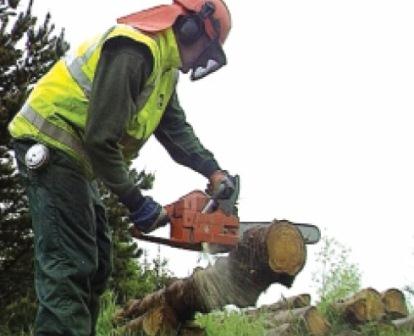Timber Work
One of the most dangerous tasks carried out on farms is felling trees and using chainsaws.
- Check the chainsaw thoroughly before use. Only use a chainsaw with correct safety devices
- Chainsaws should only be used by suitably trained and competent persons
- Tree felling should only be undertaken by competent persons and children or elderly should be kept away
- Make sure a first-aid kit, including large wound dressings, is available
- A safety helmet, suitable eye protection, ear defenders, chainsaw gloves, leg protection, safety boots and non-snag outer clothing should be worn
- Follow the Guide to safe working with timber and chainsaws
- Follow the Code of Practice for Managing Safety and Health in Forestry Operations
|  |
Using the chainsaw
- Ensure the chainsaw is properly maintained
- Make sure you know where the controls are, and that they are all in working order
- To prepare to start the engine, hold the saw firmly in position on level ground
- Apply the chain brake when the chainsaw is not in use
- Shut off the engine before moving from one area to another
- Never leave the chainsaw unattended while it is idling
- Never use the chainsaw above shoulder height or when you are off balance
Avoiding kickback
- Make sure that the chain and chainsaw are adequately maintained
- Never begin cutting with the upper half of the nose of the blade. While cutting, watch out for branches, logs or other material that could come into contact with the danger zone
- Grip the saw properly, using both hands. The thumb of the left hand should be under the handle
- Before cutting, your left arm should be straight. In the event of kickback, this will help to divert the saw over your body
- Never run the engine slowly at the start or during cutting, as this can lead to kickback
Work area precautions
- When cutting lengths of timber, such as firewood, make sure the timber is securely supported and that other people are at least two saw-lengths away
- When preparing to cut a tree or branches
- Clear any undergrowth likely to interfere
- Prepare a path of safe retreat to the rear, diagonal to the line of a tree's fall
- Make sure your foothold is firm and obstruction-free
- If working on sloping ground, work from an uphill position
- Lopping branches off trees and working on ditches is extremely dangerous. Use a platform such as a tractor trailer to provide a secure non-slip foothold
|  |
Felling trees
- Make sure the chainsaw operator has the necessary training
- Consider factors such as the wind, the natural lean and balance of the tree, location of large limbs, and whether the trunk is sound, hollow or partially rotted
- Watch out for dead limbs overhead and for overhead power lines
- Make sure that bystanders are at a safe distance
- Watch out for 'spring poles' or conditions where a log or tree is under tension